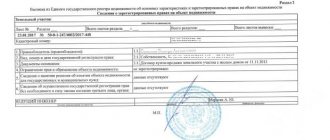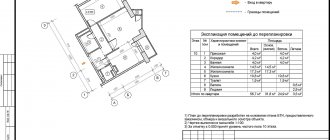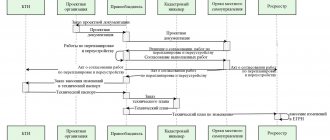The Unified State Register of Real Estate, also known as the Unified State Register of Real Estate, is a single information resource created and operating since 2021, introduced to record and store information regarding rights to real estate and themselves. This resource is available throughout the Russian Federation and serves as a replacement for the Unified State Register and Cadastre.
Such legislative changes in many spectrums are justified, on the one hand, by convenience for the population and government bodies, on the other hand, they provide additional protection against fraud in the real estate market.
The new register contains data from the cadastral database and all information from Rosreestr, so that in order to enter, receive or change it, you no longer need to contact several different authorities. This simplifies the registration, re-registration, and adjustment procedures
data and complicates fraudulent activities, since the user of the database now has a complete picture. The same can be seen by a citizen who orders an extract of information from the Unified State Register of Real Estate.
The work of the unified register is fully regulated by the Procedure for maintaining the Unified State Register, which is officially approved by the Ministry of Economic Development.
Dear readers!
Our articles talk about typical ways to resolve legal issues, but each case is unique. If you want to find out how to solve your specific problem, please contact the online consultant form on the right →
It's fast and free!
Or call us by phone (24/7):
If you want to find out how to solve your particular problem, call us by phone. It's fast and free!
+7 Moscow,
Moscow region
+7 Saint Petersburg,
Leningrad region
+7 Regions
(free call for all regions of Russia)
Procedure for entering information
Information regarding cadastral registration and state registration of property rights is now combined into the Unified State Register of Real Estate. Legislative changes introducing the new system came into force starting in 2021. Accordingly, the procedure for entering and changing information in a single database was changed.
Thus, if previously state registration had to be carried out only after filing a corresponding application, which could only be done by a limited circle of persons, now the basis for this is the submission of documents. There are several procedures for entering information into the register:
- When registering;
- Carrying out accounting when concluding a transaction, which must be registered;
- When interdepartmental structures interact;
- Notification entry.
Registration means the initial registration of a real estate property. As for accounting for transactions, be it a sale, purchase, rental, lease, gift or other, here the initiator of changes is the applicant, who re-registers the property rights to himself. Interdepartmental interaction does not affect the ordinary population. It represents the redirection of information between government agencies.
Ways to make changes
Changes in the register are made at the initiative of the owner, after filing an application. Other persons cannot participate in this process, only with a notarized power of attorney. Also, adjustments are made based on a court decision.
How to make changes:
- Contact the MFC and submit an application.
- Contact the Rosreestr office.
- Go to court if the first two methods do not help.
In some cases, it is not possible to resolve the issue on your own. For example, when the cadastral value of real estate is underestimated or overestimated, changes can only be made through the court.
Notification procedure
Separately, it should be noted the notification procedure, the purpose of which is to secure the rights to enter information about objections to registration actions. In other words, a citizen who was previously the owner of a real estate property has the right, within five days from the date of registration actions, to file his objection if he has compelling reasons for doing so. On the other hand, it is permissible not only to object, but also to protect the rights of the current owner of the object. He can also submit an application according to which changes will be made to prohibit registration activities for a specified period. The specified period is usually considered to be the date of the court decision.
Such an innovation with a unified registry reduces the time required to complete all procedures and the time required to obtain the necessary data. Since government agencies no longer need to send official requests anywhere and wait for a response, the difference is more than noticeable.
On the other hand, the list of confidential information and who exactly can be considered interested in receiving information has not been fully thought out. Therefore, the old rules still apply here.
On the procedure for entering information into the Unified State Register of Real Estate
Information on state registration of rights and cadastral registration with the entry into force of Federal Law No. 218-FZ of July 13, 2015 will be contained in a single information code - USRN. The majority of changes in this area will come into force on January 1, 2021. The procedure and methods for entering information and changes to information in the Unified State Register will change significantly.
Previously, registration actions were carried out solely on the basis of an application submitted by a limited circle of persons, enshrined in Art. 16 Federal Law No. 122-FZ. From January 1, 2021, registration of rights and registration of real estate can be initiated by application or submission of documents. The legislator established three procedures: registration, accounting based on transactions subject to registration, interdepartmental information interaction and notification.
1. Based on the results of the transaction (lease, purchase and sale, donation, etc.), applicants independently initiate registration of rights and cadastral registration by submitting an application to the Unified State Register of Real Estate.
2. The procedure for interdepartmental information interaction obliges state and municipal authorities to send documents based on the results of making any decisions for the purpose of carrying out registration and accounting actions. Also, Federal Law No. 218-FZ obliges the notary who issued the certificate of inheritance to provide information about the person and real estate to the Unified State Register of Real Estate within 3 days. Previously, authorities and the notary had the right to provide documents and information to the Unified State Register, which created uncertainty in the applicant’s actions and delayed the process of registration of rights and accounting.
In case of violation of the deadlines for the provision of documents in the order of interdepartmental information interaction by authorities, registration and accounting actions can be carried out at the request of the interested person. In this case, the rights registration authority independently requests information within 3 days.
3. The notification procedure establishes the right to make a record of the existence of an objection to the registration action in relation to real estate. The former copyright holder has the opportunity to submit an application within 5 days after the registration action has been completed. In addition to the filing of an objection by the former copyright holder, the current owner, in a declarative manner, can make an entry about the impossibility of registering the right without his participation. Such a record will allow the owner to protect and preserve his rights until the dispute is resolved in court. The entry will be invalid if there is already a judicial act for this registration action.
Of course, innovations speed up the process of registration of rights and cadastral registration. Particularly significant is the introduction of interdepartmental information interaction, which specifies the rights and obligations of participants in relations during the registration of rights and cadastral registration.
Meanwhile, a gap is seen in the absence of sanctions against state and municipal authorities that violated the interdepartmental procedure for providing documents, despite the fact that the legislator anticipates such a violation, and therefore allows the interested party to initiate registration and (or) accounting action if the authorities authorities will not provide documents within the prescribed time frame. Also, Federal Law No. 218-FZ does not indicate which persons should be considered interested.
Lawyers of the Real Estate practice
Legal
August 18, 2015
What changes are we talking about?
The procedure for making changes to the Unified State Register involves making additions, corrections, and deleting information to the database. For such actions, it is necessary to confirm that changes to the immovable object or rights to it actually occurred. That is, one statement will not be enough.
For a better understanding, we can indicate which sections can be changed in relation to individuals:
- Names and surnames of owners of real estate (not only the actual change of owners, but also changes in names or surnames for any reason, be it marriage, return of a maiden name, personal whim);
- Details of identification documents of the owner (receipt of a passport, its replacement);
- Postal address of the property.
Speaking about the changes that need to be made in relation not to individuals, but to legal entities, these could be:
- Names of legal entities;
- Registration address of the organization, entrepreneur;
- Clarification, expansion or reduction of property area;
- Location of objects;
- Technical errors introduced due to oversight.
At the same time, if changes need to be made to the register regarding the area of the property, it will be necessary to involve a cadastral engineer who will take measurements.
When they can refuse
Service may be denied for several reasons:
- an incomplete package of documents was provided;
- the state duty has not been paid;
- it was not the owner who applied;
- passport is not valid;
- the presence of corrections or errors in the application;
- there is no basis for adjustment.
If you believe that you are being denied wrongfully, go to court.
To make it easier to make changes to the Unified State Register, please contact us to receive an extract. We issue electronic certificates for 199 rubles within 3 days.
Documents for changes
In order to determine exactly what papers are needed when making changes to the updated Unified State Register, you should clearly indicate in connection with what circumstances this was necessary. By grouping all the reasons and changes, it is possible to indicate whether they affect address landmarks, characteristics and properties of the property, as well as the details of the owners.
Standard list of documents for changes to entries in the Unified State Register:
- A written statement requesting changes in the prescribed form;
- The applicant’s personal passport or the passport of an authorized person along with a notarized power of attorney in his name;
- A receipt stating that the state fee for the service has been paid (from any bank);
- Technical documents for the real estate, cadastral plan, passport;
- Title papers for property and papers that are the basis for obtaining ownership rights;
- If available, a lease, lease, mortgage, loan or pledge agreement;
- Court decision regarding the object, if any.
You will definitely need documents that confirm what exactly has changed and on what basis. Once entered into the unified register, changes will be reflected in paper and electronic documents.
Making changes to the Unified State Register of Real Estate
If you need to make changes, you can contact.
In this case, we will prepare the following set of documents:
- application (filled out on a prepared form);
- identification document;
- receipt of payment of state duty;
- extract from the Unified State Register of Real Estate before changes;
- design documentation and permission from the Moscow Housing Inspectorate (in case of redevelopment).
Providing data from the Unified State Register is a paid service. The cost of obtaining a USRN extract for individuals and legal entities is 400 rubles. It is worth keeping in mind that you can order and receive an extract from Rosreestr either by email or in paper form.
You will receive the current extract from the Unified State Register within 3 working days, and the changed one – within 10 working days. In certain cases, you may be denied information, for example if:
- not all documents have been provided;
- the state duty has not been paid;
- illegal redevelopment.
Therefore, in the case of redevelopment of a residential or non-residential property, it is important to adhere to the following steps:
- preparation of all necessary documents (technical passport BTI, title documents and others);
- development of project documentation;
- approval by administrative authorities;
- obtaining an order from the Moscow Housing Inspectorate;
- carrying out repair work;
- passing the housing inspection commission;
- carrying out an inventory by a BTI technician;
- preparation of a technical plan for an apartment or non-residential premises;
- making changes to the Unified State Register and receiving an extract.
provides services for the production of technical and design documentation, approval by administrative authorities, making changes to Rosreestr and obtaining new documents.
The cost of the service for making changes to the Unified State Register for residential premises is 15 thousand rubles, for non-residential properties - 30 thousand rubles. The service completion period is 15 working days.
If you do not know all the intricacies of coordination and/or do not have enough free time, then contact us. We have many years of experience in this field of activity, and we also have established interaction with specialists from the cadastral chamber and Rosreestr. Therefore, we will quickly prepare a technical plan, on the basis of which we can make changes to the Unified State Register and obtain updated documents for you.
Call us by phone for a free consultation or send your requests by email [email protected]
We are always happy to help you!
Application procedure
Submission of documents, along with the method of making changes to existing information in the database, will directly depend on the nature of the information to be changed.
No deadlines were set for making changes to the Unified State Register, since the tasks are too separate and each of them requires an individual approach. However, the process is often completed within a week if it is carried out through Rosreestr, and from one day to several weeks if through intermediary organizations, including private ones. There are several ways to submit an application and documents:
- Personal appeal to Rosreestr, Multifunctional Center;
- Calling a specialist to the specified address of the customer;
- Private organizations.
It is important to note that changes cannot be made by electronic request through the Rosreestr website, government services or other resource. For such a procedure, only original documents are important. No copies can be considered valid reasons. Rosreestr has the right to conduct additional checks and examinations to ensure the relevance and veracity of the information.
When to make changes
After registering a property, information about it is entered into the Rosreestr. Information is stored indefinitely, until the property is liquidated. And changes are made in cases where previous information loses its relevance.
In what cases do you need to make adjustments to the available information:
- Redevelopment. If the area, number and location of rooms, communications or doors have changed, then the redevelopment is approved by the BTI. After receiving supporting documents, changes are made to the register.
- Construction. The construction of a new facility on your own land plot leads to registration of real estate and amendments to the Unified State Register of Real Estate.
- Change of owner. In this case, the property ownership history is adjusted.
- Encumbrance. If real estate is used as collateral when receiving a loan, then documents are submitted to the Unified State Register of Real Estate, where a mark on the encumbrance is placed.
- Errors in documents. They can be detected immediately after obtaining rights to real estate or during operation. In any case, the presence of errors is another reason for contacting Rosreestr.
- New owner details. When changing the name, surname or patronymic, the owner must contact Rosreestr and submit the data of the new passport.
It may be necessary to make changes to the Unified State Register in other situations. But the purpose of these actions is the same - to correct the information in the Real Estate Register. They must be current at the time of sale, exchange or donation of the object, otherwise the transaction will not take place.
What data is included in the register?
The real estate register is maintained exclusively in Russian. An electronic form was also created, for which the federal state information system is used. In addition, a coordinate system is used to enter information, that is, cartography projection zones, if any, are necessarily taken into account, and also provide a connection between all the information available in the Unified State Register of Real Estate. Cadastral division must also be included in a single register. The structure of such records and changes in them is as follows:
- District cadastral number;
- Cadastral number of the area that is part of the district;
- Cadastral number of the block within the district;
- Name of the cadastral region;
- Location of the boundaries of the cadastral section.
The boundaries are described in detail, with a list of all coordinates, with all characteristic points for each county, district, block, property. A text basis for division according to the cadastre is entered, which can be changed if any reorganization occurs. The database contains each detail of the order of the registration authority, as well as the dates when the information was entered and changed.
Sequence of entries
The sequence of making changes to the unified register of real estate is determined depending on the sequence in which applications were registered, as well as the order in which information was received, in accordance with the documentation record book. First of all, the data is included according to the following:
| After considering the application with the documents that were submitted to change the data in one of the registers | After considering the application with the documents that were submitted to change the data in both registers |
| According to the chronological sequence of receipt of applications, from the earliest registered to the most recent. If applications were received simultaneously, they will be processed in a sequence of information interactions, that is, in the order in which the data is located in the database. | First, information will be entered that relates to the boundaries of the real estate. Then information about owners, encumbrances, etc. changes. |
In any case, even if several applications for changes are received at once, priority will be given to fixing restrictions on registration and accounting of real estate. This is important so that all actions with the object are immediately stopped until the end of the trial.
How to make changes to the Unified State Register of Real Estate after redevelopment
Today it is known that, for example, in an administrative building, the legalization of this process is simplified, in particular, there is no need to go through the IAC and obtain a special permit. In order for the owner to receive the right to make changes to official documents, he only needs to present a completed redevelopment project and a special technical report. As a result of any transaction, the owner of the premises or site may change, but even this legal action does not bring about any changes to the technical parameters of the object, if in fact they are absent. Another thing is making changes in a residential premises, here you will have to comply with all the requirements applicable to the safety of the home, but again it is worth noting that all these requirements must be met at the stage of legalizing the redevelopment, and first of all, the responsibility lies with the designers who drew up the apartment redevelopment project, and housing inspection which gives its positive opinion on the redevelopment. The cadastral engineer can only prepare a technical plan based on the design documentation, and then the procedure for making changes to Rosreestr follows.
If the parameters of an apartment or house have changed radically, then the process of making changes after redevelopment becomes somewhat more complicated; this can only be done quickly and inexpensively by specialists. In particular, cadastral registration is carried out based on a previously drawn up technical plan, which actually records all the changes made to the property that is on the cadastral register.
Sections affected by changes
When changes are made to the Unified State Register of Real Estate, which also include all kinds of additions to existing records, be it in the field of cadastre or property rights, the following is indicated:
- Number according to the cadastre of real estate existing property or registration number of proprietary rights, its restrictions, encumbrance numbers, records with changes or additions;
- Changed and changeable characteristics of objects, changeable sections with registered rights, restrictions, including in transactions;
- Data on the papers that serve as the basis for making changes and additions (provided for in paragraph 51 of the Procedure for entering information into the Unified State Register of Real Estate).
When changes are made to other information available in the unified database, in accordance with the fifth paragraph of the same Procedure, they are assigned a new number. It should consist of the registration number of proprietary rights, the number of legal restrictions, encumbrances, transactions related to this section. Then, through a slash, the change or addition is assigned an individual number. At the same time, all information, even erroneous information that was available before the changes, is stored in a single registry.
How to apply for a change
In order for the information to be updated in the Unified State Register, you must personally contact Rosreestr, the MFC, or use special online resources. As a rule, changes are not made remotely, because You must provide original supporting documents. Copies are not considered valid reasons for changing information in the Unified State Register of Real Estate.
What changes are being made to the Unified State Register of Real Estate?
Making changes to the Unified State Register consists of correcting, adding and deleting information from the database. After the information in the unified register is changed, the new information is displayed in all issued electronic and paper extracts from the Unified State Register of Real Estate. In order for the information to be corrected, the interested party must provide evidence of actions taken with the property. Changes are not made on the basis of a single application.
An individual may initiate changes to the following information in the Unified State Register:
- Full name of the owners of the object - if the owners change, as well as if the owner has changed his data, for example, upon marriage.
- Details of identity documents - when replacing a passport or receiving it.
- The postal address of the object - when changing street names or numbering of houses.
We advise you to read: Registration of land ownership. How to register ownership of a land plot?
Amendments to the Unified State Register can be made in relation to legal entities:
- When changing the name of a legal entity;
- When changing the registration address;
- When increasing, decreasing or clarifying the area of an object owned by a legal entity;
- When changing the location of the object;
- To correct technical inaccuracies in entries made by mistake.
List of documents for changing information
In order to correct information in the Unified State Register, it is necessary to submit documents confirming the fact of the changes and the grounds for them. You can focus on the standard list of papers, which, if necessary, is supplemented with other documents:
- A written statement in the prescribed form;
- Passport of the applicants or passport of the authorized person and a notarized power of attorney in his name;
- Receipt of payment of the state duty for making changes;
- Papers for the property;
- Documents confirming ownership of the object;
- All contracts relating to real estate (purchase and sale, rental, pledge, mortgage, etc.);
- If there is a court decision regarding real estate.
How changes are made
Changes to the Unified State Register occur depending on what information is updated. The law does not establish specific deadlines for taking corrective action. An individual approach is used to solve each problem. Usually the issue is closed within a week. In some cases, Rosreest conducts additional checks to confirm or refute the information provided.
Are entries deleted?
As stated above, changes made do not delete data that was previously recorded. Thus, you can see the entire history of changes regarding the real estate object of interest. However, there is also such a concept as removal of an object from the cadastre and state registration, terminated ownership rights, encumbrances, restrictions, etc. In this case, the following will be indicated:
- Number of the immovable property according to the cadastre;
- Registration number of the terminated right, its restrictions, encumbrances, transactions with it;
- Information about documents that serve as grounds for removing an object from the cadastre, terminating the right of ownership, limiting or encumbering it;
- Numbers of entries with registration of newly arising rights, their restrictions or encumbrances, if, simultaneously with the previous paragraph, the transfer of property to another person is carried out.
After the removal of real estate from the cadastre, the changed section of the Unified State Register will receive archival status. In other cases described above, the section will be assigned the status of canceled. In any case, the information will still be available and will not be deleted.
Data transfer and status change
When a section receives the status of archived or canceled, it will still not be excluded from the unified register. The records will remain available not only for review, but also for further work with them. This means that, if necessary, the interested party will be able to obtain this information, including in the form of an official document.
Federal authorities, including Rosreestr, are responsible for making changes. Their responsibility is to promptly make changes in accordance with all submitted documents regarding any of the existing sections. Since the unified register combines both cadastral and title information, which is openly accessible and which is extremely important for the work of government bodies throughout the Russian Federation. Any delays are unacceptable. One of the main tasks of the USRN is to speed up work processes.
After changing the status of a record, it will no longer be considered USRN information. The information will be used to make decisions in the registration and accounting of proprietary rights, as well as real estate. Since the data will be saved, this will greatly facilitate the task if you need to compare something to detect or refute contradictions.
The Unified State Register of Real Estate (hereinafter EGRN) is a single information resource created and operating since 2021, implemented to record and store information regarding rights to real estate.
and themselves. This resource is available throughout the Russian Federation and serves as a replacement for the Unified State Register and Cadastre. Such legislative changes in many spectrums are justified, on the one hand, by convenience for the population and government bodies, on the other hand, they provide additional protection against fraud in the real estate market. The new register contains data from the cadastral database and all information from Rosreestr, so that in order to enter, receive or change it, you no longer need to contact several different authorities. This simplifies the procedure for registration, re-registration, data correction and complicates fraudulent activities, since the user of the database now has a complete picture. The same can be seen by a citizen who orders an extract of information from the Unified State Register of Real Estate. The work of the unified register is fully regulated by the Procedure for maintaining the Unified State Register, which is officially approved by the Ministry of Economic Development.
Information regarding cadastral registration and state registration of property rights is now combined into the Unified State Register of Real Estate. Legislative changes introducing the new system came into force starting in 2021. Accordingly, the procedure for entering and changing information in a single database was changed. Thus, if previously state registration had to be carried out only after filing a corresponding application, which could only be done by a limited circle of persons, now the basis for this is the submission of documents. There are several procedures for entering information into the register:
— When registering;
— Carrying out accounting when concluding a transaction, which must be registered;
— During the interaction of interdepartmental structures;
— Notification entry.
Registration means the initial registration of a real estate property. As for accounting for transactions, be it a sale, purchase, rental, lease, gift or other, here the initiator of changes is the applicant, who re-registers the property rights to himself. Interdepartmental interaction does not affect the ordinary population. It represents the redirection of information between government agencies.
Separately, it should be noted the notification procedure, the purpose of which is to secure the rights to enter information about objections to registration actions. In other words, a citizen who was previously the owner of a real estate property has the right, within five days from the date of registration actions, to file his objection if he has compelling reasons for doing so. On the other hand, it is permissible not only to object, but also to protect the rights of the current owner of the object. He can also submit an application according to which changes will be made to prohibit registration activities for a specified period. The specified period is usually considered to be the date of the court decision. Such an innovation with a unified registry reduces the time required to complete all procedures and the time required to obtain the necessary data. Since government agencies no longer need to send official requests anywhere and wait for a response, the difference is more than noticeable. On the other hand, the list of confidential information and who exactly can be considered interested in receiving information has not been fully thought out. Therefore, the old rules still apply here.
Refusal to the applicant
When a decision is made to refuse to register real estate with the state, to register property rights, or to liquidate an object from the cadastral register, this information will be entered as an addition to the Unified State Register of Real Estate. In this case, it will be indicated what exactly the refusal was. For this, in accordance with the Procedure, standard phrases are used. For example, state registration was denied or state registration according to the cadastre was denied. These are also very informative changes to the records, allowing you to carefully track the history of each object.
If there is no refusal, it does not matter what exactly the request was about, be it the liquidation of real estate from the register, its inclusion there, re-registration of ownership rights, removal of encumbrances, etc., standard additions are also made. They are represented by phrases such as “registered” or “accounting and registration completed.”
If there were any legal claims against the property, then when they are removed, the status “extinguished” is entered. When the owner of an object changes, but claims or encumbrances remain, this information is not removed and is transferred to a new account.
In what cases are changes made to the Unified State Register of Real Estate?
The legislator requires changes to be made to the Unified State Register of Real Estate in the following cases:
- redevelopment in the apartment;
- construction on a land plot;
- change of ownership;
- changing the owner’s data, for example, last name, first name - for individuals, details - for legal entities;
- detection of an error in the Unified State Register of Real Estate;
- real estate division;
- change in property type or permitted use.
The procedure for making changes will not take much time if you know the procedure. First, find out where to go to record a change.
Sections with data on property rights
In the records of the unified newly introduced register for real estate objects regarding real rights, the cadastral individual numbers, serial registration numbers and dates when real rights were registered, as well as the types of these rights, do not change. The form of ownership, however, may change. For example, state, municipal real estate, housing or land, can be privatized and become private ownership.
Most often, information about the owner to whom real rights are registered changes, since owners change as a result of transactions involving the alienation of property. Accordingly, every time the owner changes, the data on the documents that served as the basis for this change also. Other transaction details and their costs will be indicated. As additions to the Unified State Register, there are objections arising in relation to registered rights, legal disputes and temporary bans on registration, in which the owner or his authorized representative is not personally involved. Changes, in the form of additional information, also include data on the recognition of the owner as an incompetent person or partially incompetent.
In addition, the composition of residents, that is, registered citizens, the size of shared ownership, etc., may change.
Technical plan after redevelopment with amendments to the Unified State Register
order a detailed technical plan after redevelopment with changes to the Unified State Register of Real Estate from a cadastral engineer who has an engineer’s certificate and a cadastral license-membership in a specialized SRO to carry out his activities. In order to order a new technical plan for further changes to the Unified State Register, you need to study the list of certified cadastral engineers, conclude a contract agreement with the selected one and submit all the necessary documents, especially those acting as grounds for changing the parameters of the real estate (redevelopment project and technical specifications, if the premises are located in a residential building, an order and a redevelopment act from the housing inspection are required).
Next, the cadastral engineer, based on the design documentation, prepares all the necessary technical documentation based on the concluded contract, drawing up a technical plan for making changes after inexpensive redevelopment . Next, a ready-made technical plan for making changes after redevelopment, at the request of the customer, is either transferred to him for personal changes in Rosreestr, or for an additional fee is transferred to a lawyer who, on the basis of a power of attorney from the owner, will make changes after the redevelopment in Rosreestr. In addition to the application, the owner is required to provide title documents for the property; they confirm that the grounds for making changes to Rosreestr are absolutely legal.
Changing information about copyright holders
It should be taken into account that each section of the electronic form of the Unified State Register of Real Estate contains a whole series of information that can be changed not completely, but only partially. For example, consider a niche about a property owner:
- In relation to individuals who have Russian citizenship, data is entered on the last name, first name, patronymic, date of birth, citizenship, personal insurance system account number (pension), passport details or birth certificate for minors. Even if the owner does not change, then everything except his date of birth can be changed;
- In relation to individuals who do not have Russian citizenship, data is entered on the last name, first name, patronymic (if any), date and place of birth, citizenship, number on the personal individual account of the insurance system, passport details or birth certificate for minors. All documents of a foreigner are provided in his native language with an official, notarized translation;
- In relation to legal entities, absolutely everything can change.
Imposing and removing encumbrances
As for the register of proprietary rights, which are subject to restrictions and encumbrances, the following information is entered and changes over time:
- The object number according to the cadastre - only when the object is reorganized, which is tantamount to its liquidation;
- Registration number and date of imposition of encumbrances and restrictions on the property - this item does not change;
- What kind of restriction or encumbrance is imposed on the property;
- In favor of whom the restrictions were established, whose rights were limited (confidential information). You can find out about the presence of a restriction and its type, but without details for unauthorized persons;
- Information about the documents on the basis of which the encumbrances were imposed;
- Other information related to this issue;
- Presence of litigation;
- Data on the seizure of an object for the needs of the state, etc.
Notes on rent, mortgage, loan, gratuitous use, easement, management of proxies, rental housing, arrest, pledge and all kinds of prohibitions are necessarily subject to state registration with a mark in the Unified State Register of Real Estate. If any changes occur, the restrictions are lifted and a corresponding note is made in the database. The initiator is usually the property owner.
List of documents that are the basis for entering information into the Unified State Register of Real Estate
To clearly define the list of documents required for entering information into the Unified State Register, you need to correctly determine the list of circumstances. Only after identifying all the actions and changes can one say with confidence which characteristics of the object have undergone changes. It should also be understood that although in each specific case the set of documents submitted to the Unified State Register is compiled individually, there is a standard list that is mandatory for all applicants. It includes:
- Statement of the established form;
- Civil passport of the copyright holder;
- Receipt for payment of state duty;
- Technical documentation for real estate;
- Papers that became the basis for the emergence of registration rights;
- Grounds for making adjustments to the Unified State Register.
If a proxy is involved in the procedure, the service will be provided provided that the package of documents is accompanied by a power of attorney registered with a notary and the proxy’s passport.









